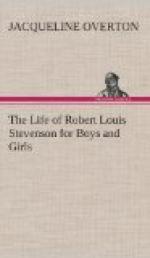At last, on Christmas Day, they were ready to depart. The entire population of Tautira came to the beach to bid them farewell, and as the Casco swung out of the harbor one of the French officials fired a salute of twenty-one guns with his army rifle and the schooner returned it with a heavy-tongued Winchester.
Tautira had grown to seem like a real home to all of them. To leave it with very little hope of ever returning to see such good friends as Princess Moe and Ori was a real grief, while they in their turn were quite heart-broken. Stevenson’s friendship had brought something into their lives they had never had before.
Honolulu was the goal of the Casco now, and all eagerly looked forward to the letters waiting for them there—the first word from home since leaving San Francisco.
Bad weather attended the Casco all the way. They were delayed by a succession of hurricanes and calms until the supply of food ran very low and they were reduced to a diet of “salt-horse” and ship-biscuit.
The last forty-eight hours of their run was made in the very teeth of a furious gale when the captain took big risks by carrying full sail, with the hope of making port before their supply of food and water was entirely exhausted. In spite of the danger, Stevenson enjoyed this daring run hugely. Later, when he and Lloyd wrote “The Wrecker” together, this very episode figured in the story, Captain Otis under the name of Captain Nares performing a similar sail-carrying feat on the schooner Norah Creina.
Mrs. Strong, Stevenson’s stepdaughter, and her family were waiting in Honolulu and gave them a warm welcome. The travellers soon found themselves the centre of interest among Mrs. Strong’s large circle of friends and it was with difficulty Stevenson found time to finish the last chapters of “The Master of Ballantrae,” which he had been working on since leaving Saranac.
Honolulu, with its street-cars, shops, electric lights, and mixture of native and foreign population, seemed strangely crowded and modern after the scenes they had recently left; too modern by far to suit Stevenson, who preferred the unconventional wild life of the islands they had come from.
At the Royal Palace in Honolulu, Kalakaua, the last of the Hawaiian kings, still held court. He enjoyed R.L.S. and invited him often to the palace and told him the history and legends of many of the islands of the South Seas. It was from Kalakaua he first learned to know the troubled history of the Samoan Islands and of Apia, which was to be his future home.
The Island of Molokai, the leper colony, lay not far off. While in Honolulu he spent several days there, in the place where Father Damien had lately done his splendid work.




